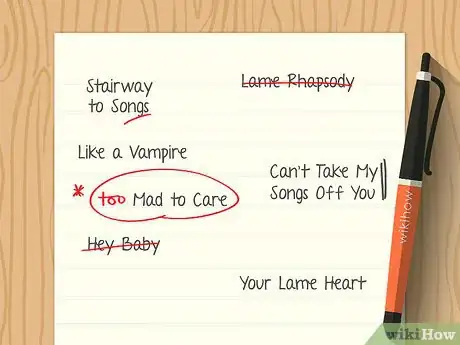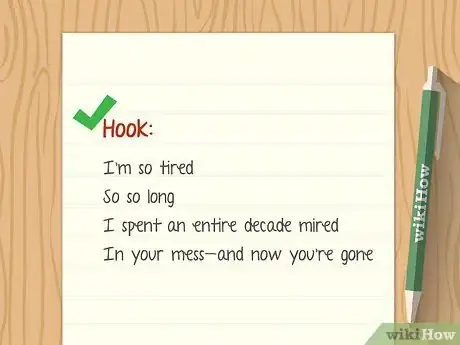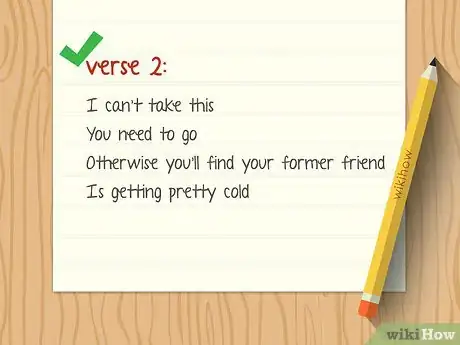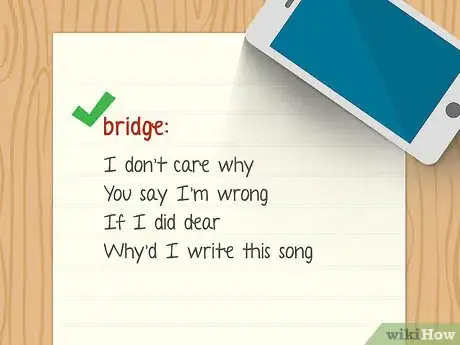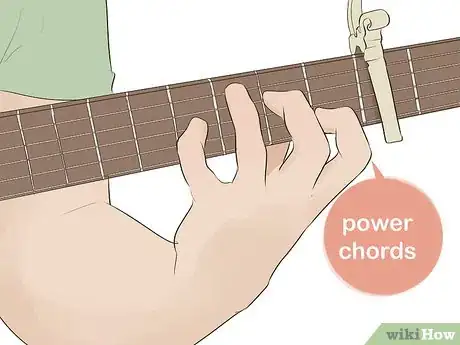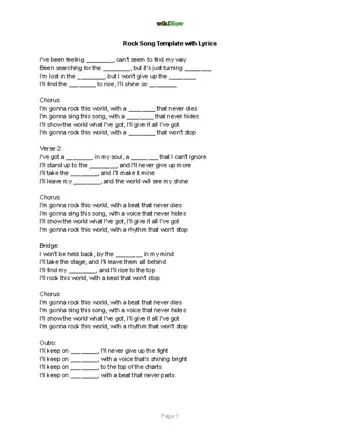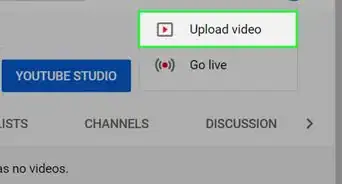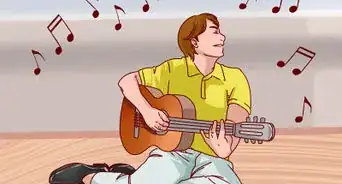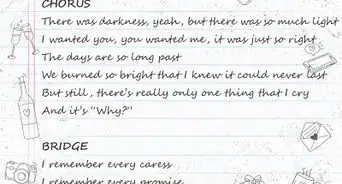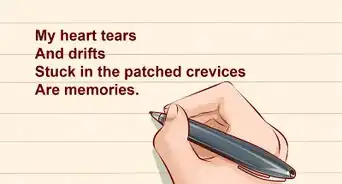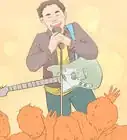This article was co-authored by Tanisha Hall. Tanisha Hall is a Vocal Coach and the Founder and Executive Director of White Hall Arts Academy, Inc. an organization based in Los Angeles, California that offers a multi-level curriculum focused on fundamental skills, technique, composition, theory, artistry, and performance at a conservatory level. Ms. Hall's current and previous students include Galimatias, Sanai Victoria, Ant Clemons, and Paloma Ford. She earned a BA in Music from the Berklee College of Music in 1998 and was a recipient of the Music Business Management Achievement Award.
There are 15 references cited in this article, which can be found at the bottom of the page.
This article has been viewed 434,196 times.
A good rock song should put your listeners on edge. It should make them want to do something dangerous, fight against the system, and have a good time. If you want to write a rock song that does all that, you’ll need to know how to brainstorm, how to write lyrics, and how to compose classic rock music. Once you do, you can blast the roof off your venue just like the pros!
Steps
Brainstorming Ideas for Your Song
-
1Decide on the themes of your song. Rock is edgy, angry, and anti-authoritarian.The most common themes in rock music are rebellion, liberation, sex, and drug use. Romantic love is also a huge theme in the genre. Use your own experiences as an inspiration. If you want your rock song to sound authentic, you’ll need to know how it feels to go through the things you’re writing about.[1]
- John Lennon’s song “Cold Turkey,” for example, is about his experience quitting heroin.[2]
-
2Come up with a title for your song. Listen for catchy phrases in real life, look for them in books, and watch out for them on TV shows and in movies. Write down anything that sticks out to you in a notebook or on your phone. These phrases can become the title of your song, and that title can be the foundation of your lyrics in the chorus and verses.Advertisement
-
3Think of a hook based on your title. Play around with your title ideas and various melodies to see if you can come up with anything particularly catchy. Once you do, that can serve as your hook, the part of the song that sticks in your listeners’ heads and stays there because it’s pithy and memorable.[3]
- A quick rule of thumb for determining a hook’s catchiness: if a lyrical or melodic phrase sticks in your head, it will probably stick in other people’s heads.
- A variation of the title of the Rolling Stones’ song “Paint It, Black,” for instance, serves as part of the hook: “I see a red door and I want it painted black.”[4]
Writing the Lyrics of Your Song
-
1Build a chorus around your hook. Because your hook is meant to be memorable, you should put it in the chorus so that it’s repeated as much as possible. Usually, musicians put the hook at the beginning or end of the chorus, or use it to bookend the chorus on both sides. The lyrics of your chorus should build off the hook and deal with the themes of the song in a vague way.
- The chorus of the David Bowie song “Starman,” for example, introduces the song’s hook, “There’s a starman waiting in the sky,” in the first line of the chorus.[5]
-
2Write the first verse of your song. While the chorus might be vague, your verses should include specific examples and concrete imagery. Build on the themes introduced in your chorus with lyrics in the verse that give your listeners a more solid idea of what your song is about.[6]
- In the first verse of “Take It Off,” for instance, The Donnas sing “I'm on my second drink/But I've had a few before/I'm trying hard to think/And I think that I want you on the floor.”[7]
-
3Pattern the other 2 verses of your song after the first. Once you’ve set the rhythm and lyrical tone of your song in the first verse, it should be fairly easy to come up with your other 2 verses. Your other verses should add to the information introduced in the first verse while keeping to the same rhythm and pattern.[8]
- In the second verse of “When Doves Cry,” for example, Prince sings “Dream if you can a courtyard/An ocean of violets in bloom/Animals strike curious poses” in the same rhythm as the first verse.[9]
-
4Think about including a bridge. A bridge is like a second chorus in your song: it deals with your themes in vague terms, but adds something new and unexpected that breaks up the monotony for your listeners. It's a transition that allows you to get creative and bring a different tone, change the beat or instrumentation, or add harmonies. As far as lyrics, the bridge can present or answer a question or emphasize the main point of your song.
- The bridge in “Barracuda” by Heart, for example, uses a different rhythm to stick out from the rest of the song: “‘Sell me, sell you, the porpoise said/Dive down deep to save my head/You, I think you got the blues too.”[10]
Composing the Music for Your Song
-
1Decide on your rhythm and beat. Your rhythm and beat will be determined largely by what particular style of rock you want to make. Punk rock has a faster, driving rhythm, heavy metal uses a 4/4 time signature (the beat is a quarter note lasting 1 second and there are 4 beats per measure), reggae rock is syncopated (beats are played off the rhythm).[11]
- Search online to find out what rhythm and beats the particular genre of rock music you want to play uses.
-
2Use power chords. Many of the most famous rock songs use power chords rather than traditional ones to give the music a less smooth, edgier sound. Power chords are formed by fingering the main note of the chord with your first finger on the top string of your guitar, then using your third and fourth fingers to press down on the 2 strings below the top string 2 frets down the neck of the guitar.[12]
- The G power chord, for example, would be formed by pressing on the third fret on the top string, then the fifth fret on the 2 strings below the top string.[13]
- Nirvana’s song “Smells Like Teen Spirit,” for example, uses the power chords for E, A, G, and C.[14]
- Power chords are particularly popular in grunge music.
- Acid rock songs use the same type of chords, but they distort the chords by using a distortion pedal hooked up to the amplifier.
- Indie rock, on the other hand, tends to go for a smoother, softer sound, and may even use traditional chords.
- Glam rock also uses smoother sounds, and tends to experiment with music from other genres entirely.
-
3Start with an electric guitar and then add in other classic rock instruments. Electric guitars have been the foundation of rock songs since the beginning. While you’re writing your song, use an electric guitar as the accompaniment and to help develop your melody. Once your finished writing your song, you can add in instruments like the drums, bass guitar, and keyboard.
- You should also remember to strum your guitar like you’re trying to break the strings. Rock music isn’t rock music without a destructive vibe.
- Funk rock, for example, emphasizes a heavy beat from the bass guitar and drums.
- Singer-songwriters like Joan Armatrading tend to focus heavily on melody instruments like guitar and piano and use other instruments mostly just to achieve a fuller sound.
-
4Feature an instrumental solo. Every great rock song has a killer instrumental solo, almost always one with an electric guitar. To write your solo, play around with scales in your song’s key and try adding in bits and pieces of your melody. Try different combinations to see what you come up with and do what you can to really show off your skill.[15]
- Psychedelic rock in particular features long, improvised instrumental solos, usually by an electric guitar.
- Punk rock, on the other hand, tends to see instrumental solos and pretentious and unnecessary.
- The iconic guitar part in the Guns N’ Roses song “Sweet Child O’ Mine,” for example, is a simple variation of a scale that Axl Rose heard guitarist Slash playing in rehearsal.[16]
Template with Lyrics
Community Q&A
-
QuestionI want to start a band with a normal guitar and a singer. Can I do this?
 Community AnswerYes, absolutely! It doesn't really matter which or how many instruments are in a band. You can make great music with just a guitarist and a singer.
Community AnswerYes, absolutely! It doesn't really matter which or how many instruments are in a band. You can make great music with just a guitarist and a singer. -
QuestionWhat would be better to learn first for my rock song learning? Harmonium or sitar?
 TorpiTop AnswererBoth are unusual choices in rock music. They have very different timbres (sounds), so listen to both, and decide which is a better fit for your the melodies you want to play and your vocal and lyrical style.
TorpiTop AnswererBoth are unusual choices in rock music. They have very different timbres (sounds), so listen to both, and decide which is a better fit for your the melodies you want to play and your vocal and lyrical style. -
QuestionCan there be a band without a guitarist. The sound just comes from the DJ?
 TorpiTop AnswererThere are many bands without guitarists - this is definitely doable. However, the guitar is the key instrument in rock music, so writing rock music without it will be a real test of your creativity.
TorpiTop AnswererThere are many bands without guitarists - this is definitely doable. However, the guitar is the key instrument in rock music, so writing rock music without it will be a real test of your creativity.
References
- ↑ http://www.reasontorock.com/elements/liberation.html
- ↑ https://genius.com/John-lennon-cold-turkey-lyrics
- ↑ https://www.bmi.com/news/entry/how-to-write-song-hooks-that-hook-you-in
- ↑ https://genius.com/The-rolling-stones-paint-it-black-lyrics
- ↑ https://genius.com/David-bowie-starman-lyrics
- ↑ https://www.musicindustryhowto.com/how-to-write-a-verse-for-a-song/
- ↑ https://genius.com/The-donnas-take-it-off-lyrics
- ↑ https://www.musicindustryhowto.com/how-to-write-a-verse-for-a-song/
- ↑ https://genius.com/Prince-and-the-revolution-when-doves-cry-lyrics
- ↑ https://www.azlyrics.com/lyrics/heart/barracuda.html
- ↑ https://www.dummies.com/art-center/music/guitar/recognizing-different-rock-guitar-rhythm-styles/
- ↑ https://www.stringkick.com/blog-lessons/power-chord-songs/
- ↑ https://www.justinguitar.com/guitar-lessons/power-chords1-bc-172
- ↑ https://tabs.ultimate-guitar.com/tab/nirvana/smells_like_teen_spirit_chords_807883
- ↑ https://spinditty.com/learning/How-to-Write-a-Guitar-Solo
- ↑ http://www.heretodaygonetohell.com/articles/showarticle.php?articleid=149
About This Article
If you have an electric guitar and a pen, writing a rock song is relatively easy. Start with either the chords or the lyrics, depending on what comes naturally to you. Common themes for rock songs are addiction, breakups, and political rebellion, but you can write about anything you want. Use power chords to come up with a chorus you like. These consist of only the first and fifth notes in a chord and are easy to play on guitar. Once you’ve got your chords or lyrics, you can start writing the other part to it. Stick to a simple verse, chorus, verse, chorus structure. Or, throw in a solo or a bridge if you’re feeling adventurous. After you’ve fit the lyrics to your guitar chords, you can write drum and bass parts to support the melody. For more tips, including how to write a cool guitar solo, read on!

